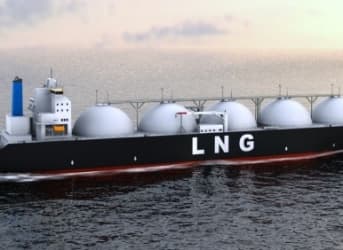The rush to export liquefied natural gas (LNG) from the U.S. might face a major obstacle: falling prices abroad.
The debate in the U.S. over whether or not to export LNG has largely subsided as the Obama administration has approved a series of proposed LNG export facilities. Though the pace at which the Department of Energy has signed off on them may not be satisfactory to LNG companies and natural gas producers, the result has been to slowly liberalize the export regime for natural gas.
While the permit approvals effectively green light LNG exports, they do not necessarily mean that there will be a market in which to operate.
A recent Reuters analysis found that LNG prices in Europe and Asia – where U.S. exporters are targeting – have fallen significantly this year. Spot prices in Asia have dropped by more than 40 percent, as demand has been slow and new supplies have come online.
According to Platts, Asian prices – known as the Japan Korea Marker (JKM) – have plummeted to $10.92/MMBtu for August deliveries, and in Europe LNG prices have slipped as well, down to $8.11/MMBtu in Northwest Europe and $8.61/MMBtu in Southwest Europe.
Not only that, but some sellers even had trouble finding buyers for deliveries in the coming months. Platts says that only one or two Japanese customers even had enough storage space to buy additional supplies for August. Prices are expected to continue to decline, so buyers are waiting to book purchases.
The JKM prices, in particular, are way off their highs, which surpassed $18/MMBtu after Japan switched off its nuclear reactors following the 2011 Fukushima meltdown. As Japan has adjusted to life without nuclear power, demand is not expected to rise (adjusting for seasonal fluctuations). And new LNG suppliers have entered the market, such as ExxonMobil’s Papua New Guinea LNG facility.
It should be noted that summer prices are traditionally softer in Asia because heating demand is low, but the unusually weak market right now is beginning to bleed into winter demand. Platts says that LNG demand for December, January, and February were weakening as the market is currently oversupplied.
Winter deliveries would still clear at a much higher prices than the current JKM price of around $11/MMBtu, but analysts do not think prices will climb back to the highs exhibited in the immediate aftermath of the Fukushima crisis.
Related article: Oil Exports, Not Exactly a Coup
That will put incredible pressure on LNG projects around the world, including those in the United States. U.S. natural gas prices may only be around one-third of those in Asia – Henry Hub hovered around $4.14/MMBtu during midday trading on July 11 – but after factoring in the cost of liquefaction, transport, and regasification, the margin is actually quite small.
As Henning Gloystein of Reuters notes, U.S. exporters would need a European price of at least $9/MMBtu and an Asian price of $10.65/MMBtu to be profitable. With the European and JKM benchmarks fluctuating right around those breakeven points, many corporate executives considering exporting LNG may have to rethink their business plans.
And there are even bigger reasons to worry. Europe is in the midst of an energy transition, which will only be accelerated after Russia’s incursion into Ukraine this year. It may take years, but the European Union will diversify away from natural gas to reduce their dependence on Russian energy.
Moreover, Japan’s pending decision to restart some of its nuclear reactors would slash demand for LNG, pulling down the JKM price further.
ADVERTISEMENT
Finally, China’s historic gas deal with Russia could mean lower LNG demand than there otherwise would have been. To be sure, China needs lots of natural gas it will drive LNG demand growth for the foreseeable future. But piped gas to China will leave less room for LNG.
Considering the high capital cost of building LNG export facilities, betting on high prices in Asia was always going to be risky. But the recent swift drop in prices has caught many by surprise.
By Nick Cunningham


















